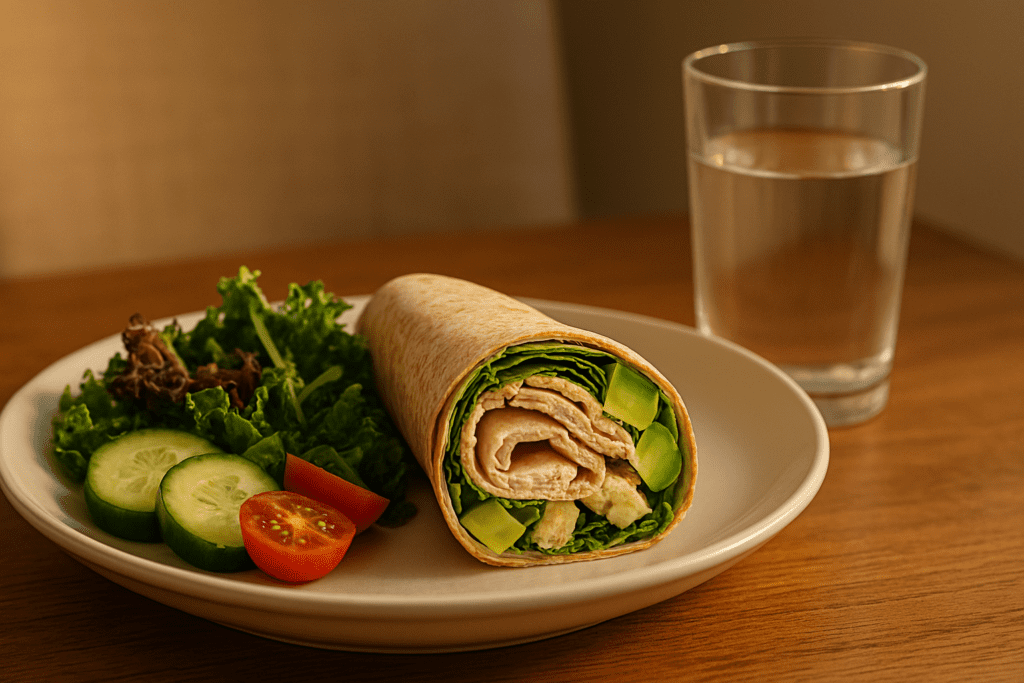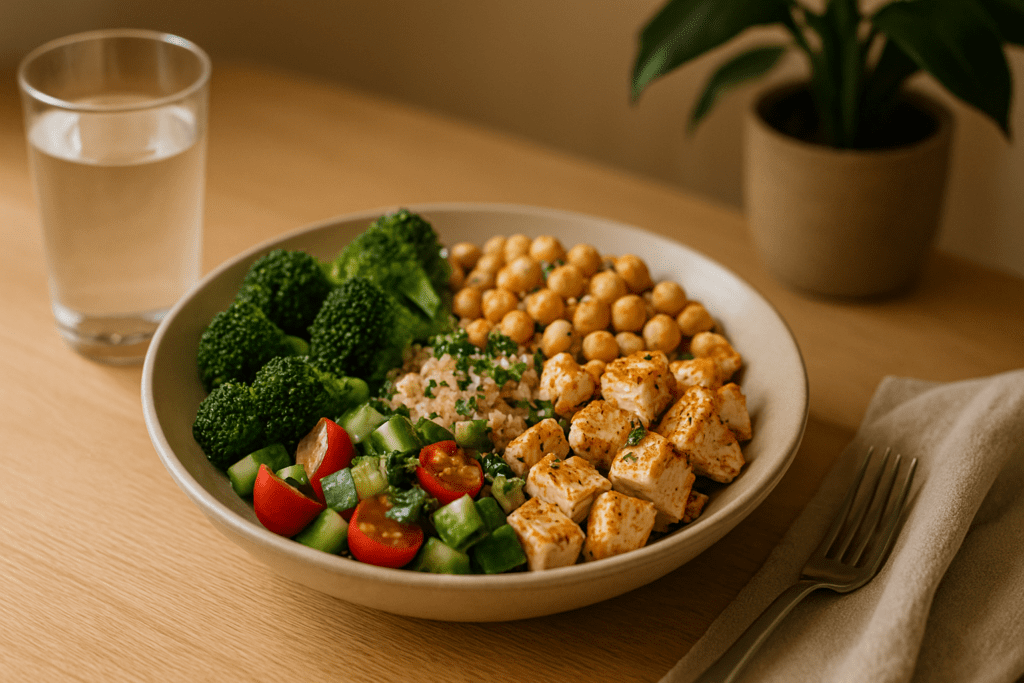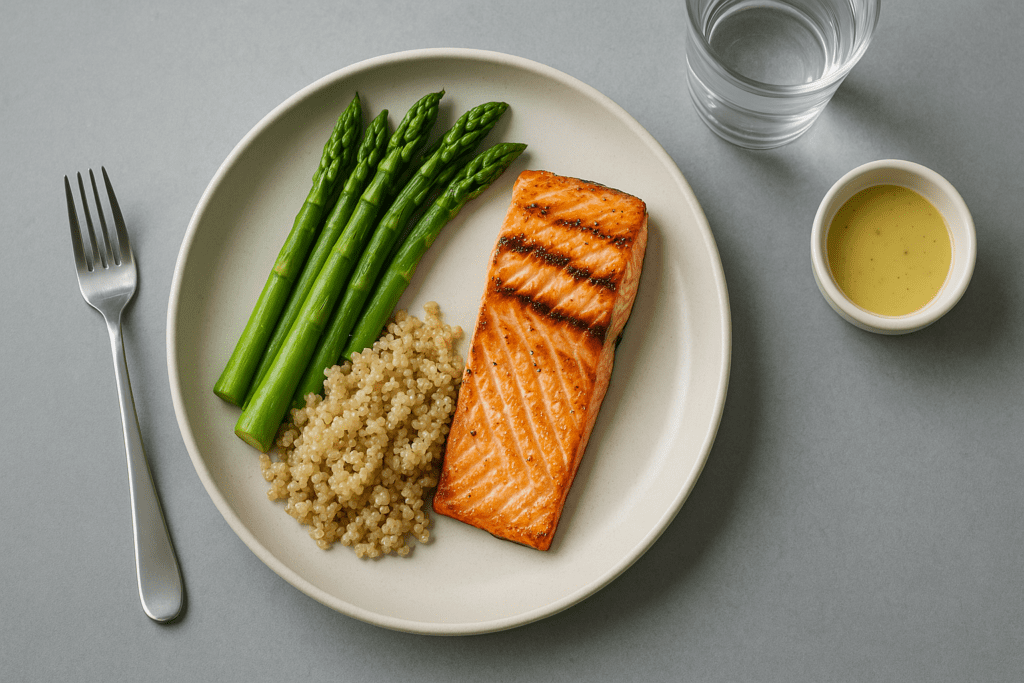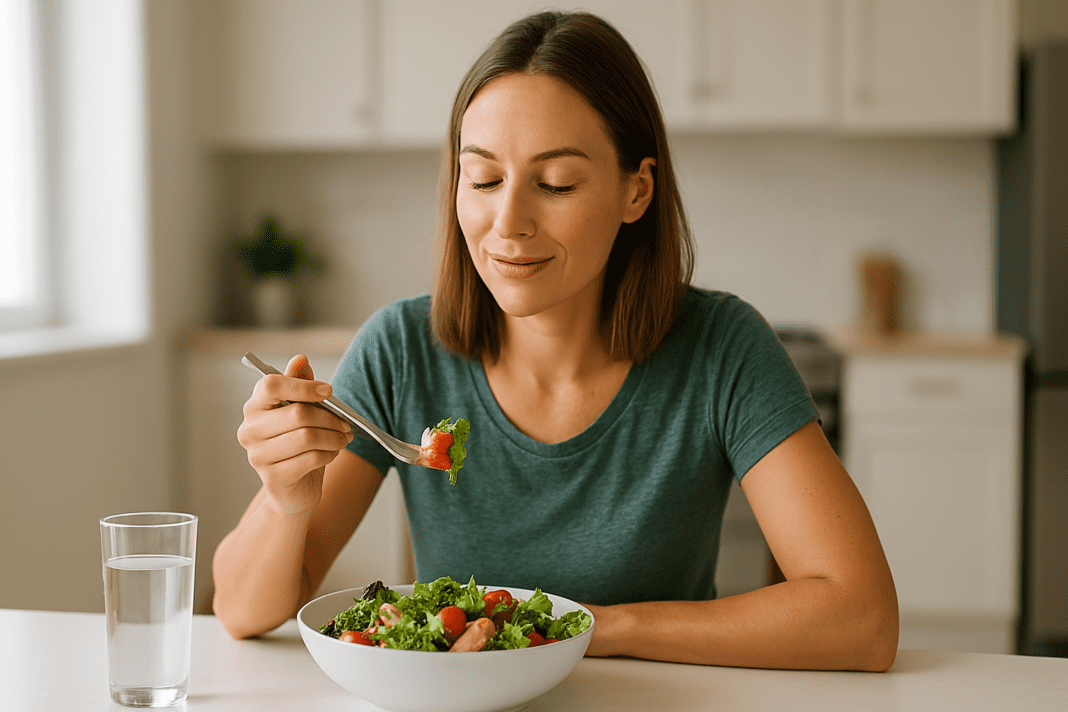Eating well at lunch doesn’t have to mean giving up taste, convenience, or satisfaction. In fact, the right combination of ingredients can help you create meals that not only support your weight loss goals but also leave you feeling energized and nourished throughout the day. With a thoughtful approach to nutrition, anyone can master the art of crafting low calorie lunch recipes that are both delicious and effective in promoting a healthier lifestyle. Whether you’re preparing meals at home or packing food for work, understanding how to balance calories, nutrients, and flavor is key to making smart midday choices. This article will explore a wide range of healthy lunch ideas for weight loss, offering practical tips, creative combinations, and insights into how the healthiest lunch to lose weight can be easier to achieve than you might think.
You may also like: Smart Healthy Eating Tips for Busy Professionals: How to Stay Nourished When You’re Always on the Go
The Power of Lunch: Why Midday Meals Matter More Than You Think
Lunch is more than a break in the day; it’s a critical opportunity to refuel the body and reset focus. Skipping lunch or reaching for something quick and processed often leads to poor choices later on, including overeating at dinner or snacking on high-calorie foods. For those focused on weight management, making intentional decisions during the lunch hour can make a significant difference in daily calorie intake. Incorporating low calorie lunch ideas into your daily routine provides an anchor point for healthy eating habits.
Scientific research continues to affirm that meal timing and nutrient balance play key roles in weight loss and maintenance. A healthy lunch for weight loss should ideally contain lean proteins, fiber-rich vegetables, whole grains, and healthy fats. This balance helps regulate blood sugar, keeps you full for longer, and prevents the energy crashes that can lead to unhealthy snacking. By incorporating easy low calorie lunches into your meal plan, you create a foundation for sustainable progress toward your health goals.
Designing the Perfect Weight Loss Lunch: Nutritional Foundations
When creating healthy lunch recipes for weight loss, it’s essential to start with a clear understanding of nutritional priorities. Protein is a cornerstone macronutrient, aiding in muscle maintenance, satiety, and metabolic health. Including sources like grilled tofu, beans, eggs, fish, or lean poultry ensures your lunch is satisfying without being calorie-heavy. For those looking specifically for low cal lunch ideas not chicken-based, legumes, quinoa, and low-fat dairy provide excellent alternatives.
Fiber is another essential component. It promotes digestive health, slows sugar absorption, and contributes to feelings of fullness. Whole grains such as brown rice, farro, barley, and whole wheat bread are ideal carbohydrate sources when planning lunch for weight loss. Adding a variety of colorful vegetables boosts not only fiber intake but also the spectrum of vitamins, minerals, and antioxidants.
Healthy fats play a vital supporting role. Rather than shunning fat altogether, it’s better to include small amounts of avocado, olive oil, or nuts, which help regulate hormones and absorb fat-soluble vitamins. Together, these components create the best lunch meals to lose weight by combining flavor, texture, and long-lasting satiety.

Creative and Satisfying Low Calorie Lunch Options
Crafting meals that are both low in calories and rich in flavor requires a blend of creativity and nutritional strategy. Some of the most popular healthy meals to lose weight at lunch include veggie-packed wraps, quinoa bowls with roasted vegetables, lentil salads with lemon vinaigrette, and soup-based options such as minestrone or miso soup with tofu.
One especially satisfying idea is a Mediterranean-style chickpea salad with cucumber, cherry tomatoes, red onion, olives, and a drizzle of olive oil and lemon juice. This colorful dish is a perfect example of a very low calorie lunch that still delivers on taste and nutrition. Likewise, zucchini noodles tossed with a small portion of pesto and grilled shrimp make a refreshing low calorie lunch recipe that keeps carbs in check.
If you’re meal prepping, a weight loss lunch box might include brown rice with stir-fried broccoli, mushrooms, and edamame, or a bento box-inspired array of sliced vegetables, a hard-boiled egg, hummus, and a small fruit portion. These lunch ideas are ideal for busy professionals and students seeking practical, portable, and delicious lunch ideas low cal enough to support their fitness journey.
Less Calorie Lunch Doesn’t Mean Less Flavor
A common misconception about low calorie lunch options is that they lack excitement or indulgence. In truth, with the right herbs, spices, and cooking techniques, low fat lunch recipes can be as bold and satisfying as their higher-calorie counterparts. Roasting vegetables with a pinch of smoked paprika or cumin can transform their flavor, while citrus zest, garlic, and fresh herbs elevate simple grain salads or soups.
Umami-rich ingredients such as mushrooms, sun-dried tomatoes, and miso paste offer complexity to meals without adding excess fat or calories. Even condiments, when used sparingly, can enhance taste profiles. A small dollop of Greek yogurt can replace sour cream in wraps or burrito bowls, while mustard, hot sauce, and vinegar-based dressings offer sharpness without the need for high-fat ingredients.
If you’re wondering what is the healthiest lunch for weight loss that doesn’t compromise on flavor, consider options like roasted sweet potato stuffed with black beans and salsa, or a crisp lettuce wrap filled with ground turkey and Thai spices. These dishes reflect the idea that healthy lunch recipes can be vibrant and crave-worthy while remaining mindful of calorie content.
Meal Prep Strategies for Sustainable Weight Loss Success
One of the most effective strategies for incorporating weight loss lunch ideas into your lifestyle is meal preparation. By planning your weekly meals ahead of time, you reduce the likelihood of last-minute temptations or unhealthy takeout choices. Preparing easy low calorie lunches in advance also allows for better portion control, making it easier to monitor intake and maintain consistency.
Start by selecting three to five healthy lunch ideas for weight loss that align with your schedule, preferences, and available ingredients. Prepare grains, proteins, and vegetables in bulk, storing them in portioned containers to mix and match throughout the week. This approach not only saves time but ensures that healthy lunch foods for weight loss are always within reach, especially on busy days when time is limited.
For variety, rotate between cuisines and ingredient profiles. Try a Mexican-style bowl with brown rice, beans, corn, salsa, and avocado one day, followed by a Mediterranean-style wrap with hummus, cucumber, and grilled zucchini the next. Over time, these preparations become second nature, and lunch tips for weight loss such as mindful portioning and balanced plating begin to feel intuitive.
Low Fat and High Flavor: Cooking Techniques That Support Your Goals
While ingredient selection is vital, the way you prepare your food also significantly impacts calorie count and nutritional value. Steaming, baking, roasting, and grilling are all excellent methods for making low fat lunch ideas that retain flavor and texture. Avoiding deep-frying and heavy cream-based sauces helps keep fat content low while allowing natural flavors to shine through.
Using non-stick cookware, parchment paper, or air fryers can also reduce the need for added oils. When sauteing, consider using a splash of low-sodium vegetable broth instead of butter or oil to soften vegetables. Blending cooked cauliflower or white beans into soups or sauces can add creaminess without relying on dairy or heavy thickeners.
Understanding what to eat for lunch to lose weight means embracing these techniques as part of a sustainable cooking practice. Even dishes that traditionally include cheese or cream can be modified by using light alternatives or incorporating pureed vegetables for depth. The key lies in consistency and creativity, building low calorie lunch recipes that are enjoyable to make and eat.

Rethinking Traditional Lunch Favorites with a Healthier Twist
Craving something classic like a sandwich or pasta dish doesn’t mean you have to abandon your goals. Many comfort foods can be adjusted to become part of a healthy lunch for weight loss with a few smart substitutions. Swapping out white bread for whole grain or lettuce wraps instantly improves the fiber content of your meal, while using mustard or mashed avocado instead of mayonnaise can significantly lower fat intake.
Whole grain pasta with vegetables and a light tomato-based sauce becomes one of the best lunch foods for weight loss when paired with lean protein such as grilled chicken or lentils. Even pizza can be reimagined using a whole wheat tortilla base, tomato sauce, and vegetable toppings baked in the oven until crisp.
These small adjustments make it easier to decide what can I eat for lunch to lose weight while still enjoying familiar flavors. It’s not about restriction, but about making empowered choices that align with your lifestyle and health goals.
Mindful Eating and Portion Control: The Missing Links to Lasting Results
Incorporating healthy lunch recipes is just one part of the equation. How you eat matters just as much as what you eat. Mindful eating involves paying close attention to hunger cues, chewing slowly, and eliminating distractions such as screens during meals. These practices help prevent overeating and increase awareness of satiety signals.
Portion control is also key. Even healthy meals to lose weight lunch options can become calorie-heavy if serving sizes are excessive. Using smaller plates, measuring ingredients, and being conscious of added fats or dressings can help maintain balance. When packing a weight loss lunch box, consider including a modest portion of fruit or a small square of dark chocolate to curb afternoon cravings without derailing your progress.
Consistency with these habits builds a healthier relationship with food. Over time, questions like what to have for lunch to lose weight become easier to answer because your body and mind become attuned to the rhythms of nourishment, satisfaction, and restraint.
Putting It All Together: The Best Lunch to Lose Weight Is the One You Enjoy
The most effective low calorie lunch options are those that align with your taste preferences, daily schedule, and lifestyle needs. There is no one-size-fits-all solution, which is why experimentation is so valuable. You might discover that soups work best during colder months, while salads and wraps are more refreshing in the summer.
It’s also helpful to remember that the best lunch meals to lose weight are not necessarily the ones that are the lowest in calories, but the ones that keep you full, energized, and motivated to continue making healthy choices throughout the day. That balance of nutrition, enjoyment, and practicality is what sets a successful lunch routine apart.
With so many healthy lunch ideas now accessible—from very low calorie lunch options to hearty, balanced bowls—there has never been a better time to rethink what lunch means. Whether you’re building your meal at home or assembling it from components at a salad bar, you can always find a way to make lunch work for you.
Frequently Asked Questions (FAQ) About Easy Low Calorie Lunches That Support Weight Loss
What are some innovative ways to make low calorie lunch recipes more filling? Many people find that low calorie lunch recipes leave them hungry shortly after eating, but this issue can be addressed by strategically using high-volume, low-calorie ingredients. Incorporating foods rich in water and fiber, such as cucumber, zucchini, and leafy greens, can increase the size of your meal without significantly increasing calories. Additionally, incorporating protein-rich grains like farro or bulgur, as well as plant-based proteins like lentils and edamame, can make healthy lunch ideas feel more substantial. Using umami-rich ingredients like sun-dried tomatoes or mushrooms enhances satiety by improving flavor, while broth-based soups served with fiber-rich sides are excellent options for easy low calorie lunches that satisfy. By balancing volume, flavor, and texture, you can create healthy lunch ideas for weight loss that feel indulgent without exceeding your calorie goals.
How can I diversify low cal lunch ideas not chicken to avoid dietary boredom? Relying heavily on chicken can make healthy meals to lose weight lunch feel monotonous, but there are countless other protein sources that can invigorate your lunch rotation. Tofu, tempeh, canned salmon, sardines, lentils, and chickpeas provide excellent texture and flavor profiles without requiring a lot of preparation. Roasted portobello mushrooms can mimic the heartiness of meat while keeping the calorie count low, and pairing them with bold spices or tangy vinaigrettes keeps meals exciting. International cuisines also offer a rich array of low calorie lunch options—from Vietnamese rice paper rolls with shrimp to Indian-style lentil dal. Exploring these alternatives not only satisfies the palate but ensures you’re getting a broader spectrum of nutrients with your low fat lunch ideas.
What psychological strategies help maintain consistency with healthy lunch recipes for weight loss? Maintaining dietary consistency is as much a psychological endeavor as it is a nutritional one. One effective strategy is to pair healthy lunch recipes for weight loss with a consistent daily routine or ritual, such as a lunchtime walk or journaling practice. This helps create a sense of structure and purpose that reinforces positive behavior. Visualization techniques, like imagining how you’ll feel after making a smart food choice, can also build motivation. Additionally, keeping a rotating collection of your favorite healthy lunch recipes makes the decision-making process less mentally taxing. By reducing cognitive friction and incorporating mindfulness, lunch for weight loss becomes not just a goal, but a sustainable lifestyle choice.
Are there specific food pairings that boost nutrient absorption in healthy lunch foods for weight loss? Absolutely. The composition of your meal significantly impacts how well your body absorbs nutrients. For example, pairing leafy greens with a small amount of healthy fat, such as olive oil or avocado, improves the absorption of fat-soluble vitamins A, D, E, and K. Similarly, combining iron-rich plant foods like lentils or spinach with a source of vitamin C (e.g., bell peppers or lemon juice) enhances iron bioavailability. For those building low fat lunch recipes, incorporating a bit of citrus or fermented food like kimchi or sauerkraut can support digestive health and micronutrient uptake. These strategic combinations allow you to get more out of your healthy meals to lose weight lunch without increasing the calorie content.
How can I modify my weight loss lunch box for travel or outdoor settings? When creating a weight loss lunch box for travel or outdoor activities, portability and food safety become top priorities. Focus on shelf-stable or minimally perishable items like vacuum-sealed tuna, roasted chickpeas, whole grain crackers, and nut butter packets. Salads made with hearty greens like kale or cabbage will hold up better than delicate lettuces and can be pre-dressed with vinaigrettes that don’t require refrigeration. To maintain variety in your lunch ideas low cal travelers can rely on, include single-serve hummus, fruit, or hard-boiled eggs, packed with ice packs. Insulated containers also allow for transport of hot soups or stir-fried grains, keeping low calorie lunch ideas enjoyable no matter where you are. Planning ahead ensures you maintain your dietary goals even on the go.
What overlooked ingredients are excellent for creating the healthiest lunch to lose weight? Some of the most underrated ingredients for crafting the healthiest lunch to lose weight are packed with both flavor and nutrients. Jicama, for instance, is a crunchy, water-dense root vegetable that adds bulk and fiber to salads and slaws. Seaweed, often used in sushi, is a low calorie lunch enhancer rich in iodine and antioxidants. Another powerful yet underused option is canned pumpkin, which can be stirred into soups or grain bowls to add creaminess and vitamin A. Incorporating pickled vegetables can also boost flavor and gut health while keeping your calorie count low. These lesser-known ingredients elevate your best lunch meals to lose weight from routine to refreshingly innovative.
How does hydration influence the effectiveness of lunch tips for weight loss? Hydration plays a subtle but powerful role in how our bodies process food and signal hunger. Many people mistake thirst for hunger, leading to unnecessary snacking or oversized portions during meals. Drinking a glass of water 15 to 30 minutes before eating can help reduce overeating and allow for better assessment of true hunger. Including hydrating foods such as cucumbers, oranges, and watermelon in your lunch tips for weight loss strategies not only supports digestion but also contributes to your daily water intake. Staying hydrated ensures your metabolism runs efficiently, making your efforts with healthy lunch ideas for weight loss more impactful.
What are common mistakes that can make low calorie lunch recipes less effective for weight loss? One frequent misstep is underestimating the calorie contribution of dressings, sauces, and toppings. While your base ingredients may align with low calorie lunch recipes, adding multiple tablespoons of oil, cheese, or creamy condiments can quickly elevate the meal into higher calorie territory. Another issue is failing to include enough protein or fiber, which are essential for satiety. Skipping these elements may lead to increased snacking later in the day, undermining your healthy lunch for weight loss efforts. Portion distortion, especially with “healthy” snacks like granola or dried fruit, can also throw off calorie calculations. To truly optimize low calorie lunch options, every component—no matter how small—should be assessed for its role in overall calorie balance.
What seasonal factors should I consider when choosing what to eat for lunch to lose weight? Seasons affect both ingredient availability and our cravings, so adapting what to eat for lunch to lose weight can improve dietary adherence. In warmer months, people often gravitate toward lighter fare like cold salads, chilled soups, or fresh fruit—making it easier to prepare very low calorie lunch options. Conversely, colder seasons may call for comforting but still healthy lunch recipes like lentil stews, roasted vegetable bowls, or warm grain salads with herbs and citrus. Eating seasonally also tends to be more cost-effective and environmentally sustainable. Integrating seasonal produce not only boosts flavor and nutrition but keeps your healthy lunch ideas exciting throughout the year.
How can I evaluate what is the healthiest lunch for weight loss in a restaurant setting? Navigating restaurant menus can be challenging, but there are key indicators that can help identify what is the healthiest lunch for weight loss while dining out. First, prioritize meals that feature grilled, steamed, or roasted components instead of fried or breaded options. Second, look for dishes that include a balance of vegetables, lean protein, and whole grains, and don’t hesitate to ask for dressings or sauces on the side. Choosing brothy soups or appetizer-sized entrees can also support your goal of enjoying low cal lunch ideas in public settings. Many establishments offer customization, so you can request low calorie lunch modifications such as replacing fries with a side salad or skipping cheese. Practicing informed decision-making makes it possible to enjoy meals out without compromising your dietary goals.

Final Thoughts: Building a Lifelong Habit of Smart, Healthy Lunching
Adopting a mindful approach to lunch isn’t about dieting or deprivation. It’s about nourishing your body, supporting your metabolism, and making consistent choices that align with long-term wellness. With a little creativity and a commitment to your goals, crafting easy low calorie lunches can become one of the most enjoyable parts of your day.
By exploring new recipes, applying simple cooking techniques, and listening to your body’s needs, you can transform the midday meal into a powerful tool for health and weight management. Whether you’re seeking low fat lunch recipes, curious about what is the healthiest lunch for weight loss, or simply aiming to find satisfying low calorie lunch ideas, remember that success lies in the details.
Every smart decision adds up. Every flavorful, low calorie lunch builds momentum. And every mindful meal brings you one step closer to the vibrant, healthy life you deserve.
nutritious lunch options, balanced lunch meals, portion control strategies, meal prep for weight loss, fiber-rich meals, healthy eating habits, nutritious work lunches, plant-based lunch ideas, low carb midday meals, smart lunch choices, nutrient-dense foods, metabolism-boosting meals, mindful eating practices, sugar-free lunch ideas, wholesome lunchbox meals, healthy food swaps, anti-inflammatory lunch recipes, dietitian-approved meals, fitness-friendly lunches, quick nutritious meals
Further Reading:
18 Low-Calorie Lunch Ideas You Can Make in 10 Minutes
17 Healthy Lunch Ideas for Weight Loss
50 Low-Calorie Meals That Pack Serious Flavor
Disclaimer
The information contained in this article is provided for general informational purposes only and is not intended to serve as medical, legal, or professional advice. While NewsHealthWatch strives to present accurate, up-to-date, and reliable content, no warranty or guarantee, expressed or implied, is made regarding the completeness, accuracy, or adequacy of the information provided. Readers are strongly advised to seek the guidance of a qualified healthcare provider or other relevant professionals before acting on any information contained in this article. NewsHealthWatch, its authors, editors, and contributors expressly disclaim any liability for any damages, losses, or consequences arising directly or indirectly from the use, interpretation, or reliance on any information presented herein. The views and opinions expressed in this article are those of the author(s) and do not necessarily reflect the official policies or positions of NewsHealthWatch.

